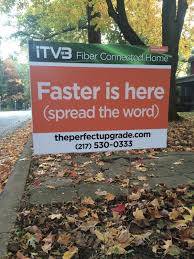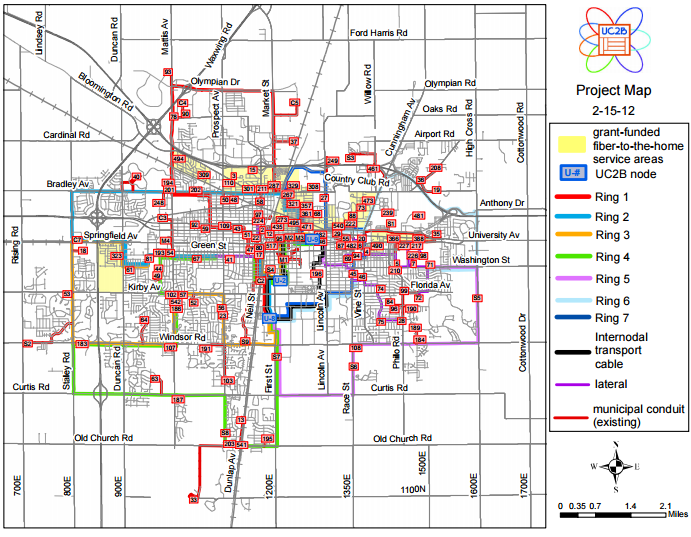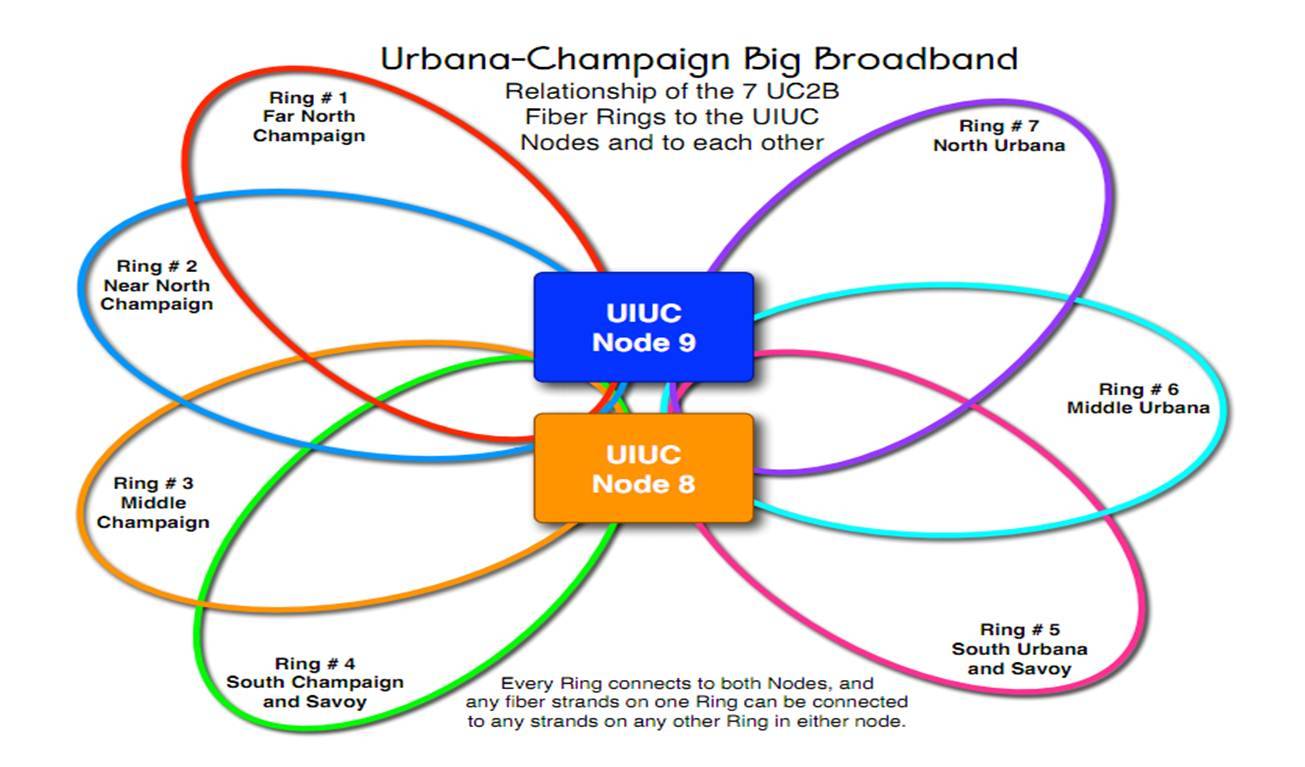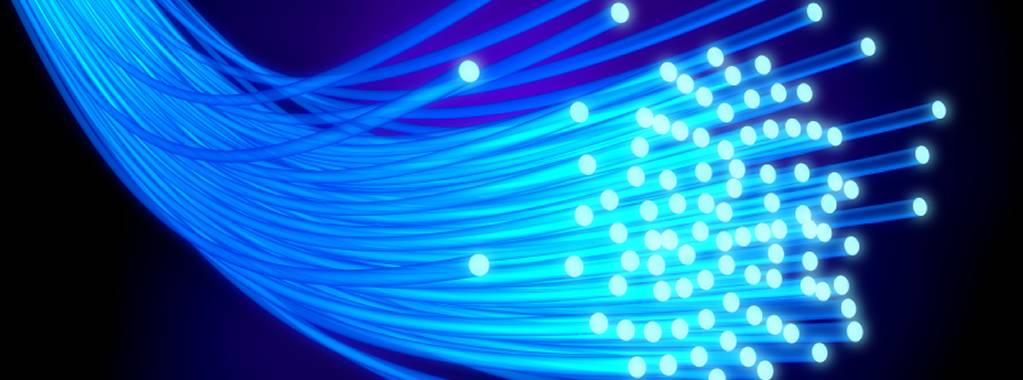
Part one of a multi-part series on fiber in C-U. Part one provides an overview of how fiber works, and looks at perhaps the most known option for super high-speed Internet, UC2B and iTV-3. But is the most familiar option necessarily the best option?
Look familiar? If you’ve strolled around certain neighborhoods in Urbana, chances are you’ve seen this sign before. But what does it mean? What’s being advertised as faster? What the heck is iTV-3? And why should we act as (unpaid, grumble, grumble) viral marketers for a campaign many of us may not understand?
Image courtesy of @UC2Bfiber on twitter
To begin to understand this campaign, it’s best to start with a little something known as UC2B.
UC2B fiber is a not-for-profit organization aiming to make Champaign-Urbana one of the few communities in the US with fiber-optic Internet, phone, and television service. To make this goal a reality, UC2B has targeted areas where broadband adoption was typically 40% or less. Additionally, UC2B provided fiber to Community Anchor Institutions (CAIs) throughout the Champaign-Urbana area. And, of course, there’s word-of-mouth advertising, which means that most of us have probably heard of UC2B even if we don’t really know a lot about fiber.
Why uproot the transmission lines already in place and spend hundreds of thousands of dollars to replace them with fiber? The answer is simple: fiber is fast, really fast. In fact, with speeds this fast (nodes can handle 16 terabytes-per-second (TBPS) of traffic according to the UC2B website), the entire Netflix repertoire could be downloaded in 30 seconds.

UC2B map. Image courtesy of cdi.lis.illinois.edu
What’s the big idea here?
The ultimate goal is that C-U will boast the most state-of-the-art Internet transmission technology in the world. Only a handful of other U.S. cities currently have fiber, including Kansas City, Missouri, and Chattanooga, Tennessee. And if this happens in C-U, UC2B and iTV-3 will provide the infrastructure that makes it all possible. You can’t get better bragging rights than that.
Most of the construction was grant-funded, making it possible to have rates as low as $19.99/month for some in-home users.

UC2B connection node map. Image courtesy of zdnet.com
It all started when the University of Illinois was awarded a Broadband Technology Opportunities Program grant from the National Telecommunications and Information Administration.
Next, UC2B was formed and started receiving funding from the Illinois Department of Commerce and Economic Opportunity as well as matching funds from the City of Urbana, the City of Champaign, the Champaign Telephone Company, the C-U Mass Transit District, Unit 4 Schools, and the University of Illinois.
UC2B then appointed members of the community to oversee construction of fiber and administrative tasks.
CAIs, identified by UC2B as “places which could potentially serve a vulnerable population,” will be receiving fiber internet. Places like Provena, Christie Clinic, Carle Hospital, Parkland College, Champaign Public Library, and many other government buildings, senior centers, youth centers, and schools throughout Champaign, Urbana and Savoy were provided fiber Internet at a nominal monthly fee, as construction costs were able to be covered by various grants awarded to UC2B.
How does fiber work?
Fiber Internet works by transmitting light through the fiber optic cables, and carrying with it information.
How exactly does light travel through a fiber optic cable? It’s pretty simple, actually. If you imagine a glass tube (the fiber optic cable) and you point a beam of light through the tube, the light will travel through the glass tube, and bounce around on the inside of the tube as it is reflects off the edges (total internal reflection).
Light has a tendency to attenuate, or lose intensity during travel. The up-side of fiber optic transmission is the relatively small amount of attenuation, meaning fiber optic cables can send high intensity signals long distances, and since the signals are traveling with light, they are going light-speed, or in layman’s terms, “super duper fast”.

Light signals passing through fiber optic cable. Image courtesy of ece.umd.edu
These signals are carrying binary information about the light emitted from the transmitting end to your home or institution. Here’s a really neat video explaining fiber optic communication.
Will UC2B/ITV-3 Fiber expand to serve the whole community?
We’ve seen the maps showing the grant-covered fiber connections. Where will fiber go next?
Well, that kind of depends on who wants fiber. UC2B teamed up with iTV-3, a Family Video company, to aid in city expansion. Basically, for places outside of the grant, iTV-3 and UC2B adopted the “Google Fiber Approach.” That is, communities might sign up for fiber, and when they show 50% subscription commitment, iTV-3 will begin providing that area with fiber. Two Urbana neighborhoods have already been recent recipients of iTV-3 Gigabit Fiber, and more neighborhoods have pledged and are due to start construction soon.
The Bigger Picture
In iTV-3’s (literal) groundbreaking video, Brandon Bowersox-Johnson concedes that Champaign-Urbana is ahead of our community peers in receiving fiber.
“Places like Silicon Valley and Seattle do not have fiber,” he proclaims, “and after all, we invented the first web browser.” To view the video, see below.
He is certainly correct. Our community is notable for vast tech innovations and for novel research in a variety of fields. Throughout history, Illinois alums have given the world MRI, Superconductors, and the pH probe (to name only a few) and in the present, our bright students and faculty have given us YouTube, LEDs, Paypal, Blue Waters Supercomputing, and much, much more.
It seems that for our beloved micro-urban oasis that we call C-U, the future and possibilities in tech are endless, and now we’re starting to get the infrastructure to match.
If you would like to bring fiber to your neighborhood through UC2B, you can subscribe here.
But UC2B isn’t the only fiber game in town. Stay tuned for Good fibes part II, where we examine other aspects of the (at time, fierce) competition to bring you lightning-fast Internet.








